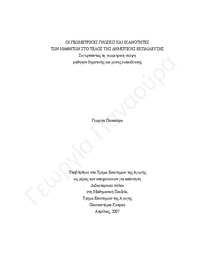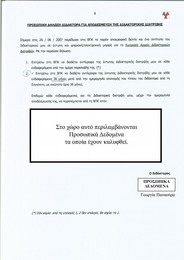| dc.contributor.advisor | Γαγάτσης, Αθανάσιος | el |
| dc.contributor.author | Παναούρα-Μάκη, Γεωργία | el |
| dc.coverage.spatial | Κύπρος | el |
| dc.coverage.spatial | Cyprus | en |
| dc.creator | Παναούρα-Μάκη, Γεωργία | el |
| dc.date.accessioned | 2012-09-21T07:35:50Z | |
| dc.date.accessioned | 2017-08-03T09:39:59Z | |
| dc.date.available | 2012-09-21T07:35:50Z | |
| dc.date.available | 2017-08-03T09:39:59Z | |
| dc.date.issued | 2007-06 | |
| dc.date.submitted | 2007-06-26 | |
| dc.identifier.uri | https://gnosis.library.ucy.ac.cy/handle/7/39232 | en |
| dc.description | Αριθμός δεδηλωμένων πηγών στη βιβλιογραφία: 187 | el |
| dc.description | Περιέχει βιβλιογραφικές παραπομπές. | el |
| dc.description | Διατριβή (διδακτορική) -- Πανεπιστήμιο Κύπρου, Σχολή Κοινωνικών Επιστημών και Επιστημών Αγωγής, Τμήμα Επιστημών της Αγωγής, Ιούνιος 2007. | el |
| dc.description | Η βιβλιοθήκη διαθέτει αντίτυπο της διατριβής σε έντυπη μορφή. | el |
| dc.description.abstract | Η παρούσα εργασία εξέτασε τις γεωμετρικές γνώσεις και ικανότητες μαθητών ηλικίας 10-14 χρόνων (Δ΄ και Στ΄ δημοτικού και Β΄ γυμνασίου) αναφορικά με το χειρισμό γεωμετρικών σχημάτων, καθώς και τις χωρικές τους ικανότητες στο μικρο-χώρο.
Με βάση την υπόθεση ότι η γεωμετρική ικανότητα χειρισμού έργων με διαφορετικά γεωμετρικά σχήματα είναι μια σύνθετη έννοια, διερευνήθηκαν οι επιμέρους συνιστώσες της. Κύρια συστατικά της ικανότητας αυτής, όπως προέκυψε από τις αναλύσεις των δομικών μοντέλων, είναι οι επιδόσεις των μαθητών στην επίλυση έργων που απαιτούσαν χειρισμό (α) γεωμετρικών σχημάτων δύο διαστάσεων, (β) γεωμετρικών σχημάτων τριών διαστάσεων και (γ) αναπτυγμάτων γεωμετρικών στερεών. Η παραπάνω δομή επιβεβαιώθηκε για τις τρεις ηλικιακές ομάδες της έρευνας.
Από τις παλινδρομικές αναλύσεις που πραγματοποιήθηκαν προέκυψε ότι οι συνιστώσες της χωρικής ικανότητας «χειρισμός νοητικών εικόνων», «νοητικές περιστροφές» και «συντονισμός των προοπτικών» αποτελούν δείκτες πρόβλεψης της επίδοσης των μαθητών σε έργα γεωμετρίας. Με τη διενέργεια αναλύσεων ομοιότητας και συνεπαγωγής διαφάνηκε ότι οι μαθητές αντιμετωπίζουν με διαφορετικό τρόπο τα χωρικά έργα και τα γεωμετρικά έργα.
Από τη σύγκριση του τρόπου χειρισμού και αντιμετώπισης των γεωμετρικών έργων ανάμεσα στις τρεις ομάδες μαθητών εντοπίστηκαν δυσκολίες και διδακτικά φαινόμενα που αφορούν τη μετάβαση των μαθητών από τη δημοτική στη μέση εκπαίδευση. Τα φαινόμενα αυτά αναφέρονται στη μετάβαση από το πλαίσιο της Εμπειρικής Γεωμετρίας (όπου τα αντικείμενα είναι υλικά) στο πλαίσιο της Εμπειρικής Αξιωματικής Γεωμετρίας (όπου τα αντικείμενα είναι θεωρητικά και η ύπαρξή τους απορρέει από αξιώματα και ορισμούς), στην ασυνέπεια του διδακτικού συμβολαίου που υφίσταται στη δημοτική και τη μέση εκπαίδευση, στη δυσκολία χειρισμού των γεωμετρικών αντικειμένων στο πλαίσιο γεωμετρική εικόνα-σχηματική έννοια και στην ισχύ του διδακτικού συμβολαίου κατά την εφαρμογή της Εμπειρικής Αξιωματικής Γεωμετρίας. | el |
| dc.description.abstract | The present study examined primary (grades 4 and 6) and secondary (grade 8) students’ geometrical knowledge and abilities related to tasks involving different geometrical figures, as well as their spatial abilities in micro-space.
Based on the assumption that students’ ability to solve tasks involving different geometrical figures is not a unitary construct, we developed a model to investigate its subcomponents. Confirmatory factor analysis affirmed the existence of three constructs of this geometrical ability: (a) the students’ ability to work with tasks involving 2D geometrical figures, (b) the ability to work with tasks involving 3D geometrical figures and (c) the ability to work with net-representations of 3D geometrical figures. Multiple group analysis results supported the invariance of this structure across the three age groups of students.
Results revealed that students’ spatial ability constitutes a strong predictor of their geometry ability concerning tasks involving different geometrical figures. Regression analyses results suggest that image manipulation, mental rotation and coordination of perspectives are predicting factors of primary and secondary students’ geometry performance.
Comparing the geometrical reasoning of primary and secondary school students was mainly based on the way students confronted and solved different geometrical tasks, the strategies they used and the common errors appearing during the solution procedure. This comparison shed light to students’ difficulties and phenomena related to the transition from Natural Geometry (the objects of this paradigm of geometry are material objects) to Natural Axiomatic Geometry (definitions and axioms are necessary to create the objects in this paradigm of geometry) and to the inconsistency of the didactical contract implied in primary and secondary education. | en |
| dc.format.extent | v, 206 σ. : εικ. ; 30 εκ. | el |
| dc.language.iso | gre | en |
| dc.publisher | Πανεπιστήμιο Κύπρου, Σχολή Κοινωνικών Επιστημών και Επιστημών Αγωγής / University of Cyprus, Faculty of Social Sciences and Education | |
| dc.rights | info:eu-repo/semantics/openAccess | en |
| dc.rights | Open Access | en |
| dc.subject.lcsh | Learning ability | en |
| dc.subject.lcsh | Reasoning in children | en |
| dc.subject.lcsh | Geometry, Study and teaching (Elementary) | en |
| dc.subject.lcsh | Spatial ability | en |
| dc.title | Οι γεωμετρικές γνώσεις και ικανότητες των μαθητών στο τέλος της δημοτικής εκπαίδευσης: συγκρίνοντας τη γεωμετρική σκέψη μαθητών δημοτικής και μέσης εκπαίδευσης : δισακτορική διατριβή | el |
| dc.type | info:eu-repo/semantics/doctoralThesis | en |
| dc.contributor.committeemember | Γαγάτσης, Αθανάσιος | el |
| dc.contributor.committeemember | Χρίστου, Κωνσταντίνος | el |
| dc.contributor.committeemember | Δημητρίου, Ανδρέας | el |
| dc.contributor.committeemember | Κυριακίδης, Λεωνίδας | el |
| dc.contributor.committeemember | Λεμονίδης, Χαράλαμπος | el |
| dc.contributor.committeemember | Gagatsis, Athanasios | en |
| dc.contributor.committeemember | Christou, Constantinos | en |
| dc.contributor.committeemember | Demetriou, Andreas | en |
| dc.contributor.committeemember | Kyriakides, Leonidas | en |
| dc.contributor.committeemember | Lemonides, Charalambos | en |
| dc.contributor.department | Πανεπιστήμιο Κύπρου, Σχολή Κοινωνικών Επιστημών και Επιστημών της Αγωγής, Τμήμα Επιστημών της Αγωγής | el |
| dc.contributor.department | University of Cyprus, Faculty of Social Sciences and Education, Department of Education | en |
| dc.subject.uncontrolledterm | ΓΕΩΜΕΤΡΙΚΕΣ ΙΚΑΝΟΤΗΤΕΣ | el |
| dc.subject.uncontrolledterm | ΓΕΩΜΕΤΡΙΚΗ ΣΚΕΨΗ | el |
| dc.subject.uncontrolledterm | ΧΕΙΡΙΣΜΟΣ ΓΕΩΜΕΤΡΙΚΩΝ ΣΧΗΜΑΤΩΝ | el |
| dc.subject.uncontrolledterm | ΧΩΡΙΚΕΣ ΙΚΑΝΟΤΗΤΕΣ | el |
| dc.subject.uncontrolledterm | ΜΑΘΗΤΕΣ ΔΗΜΟΤΙΚΗΣ ΚΑΙ ΜΕΣΗΣ ΕΚΠΑΙΔΕΥΣΗΣ | el |
| dc.subject.uncontrolledterm | GEOMETRICAL ABILITIES | en |
| dc.subject.uncontrolledterm | GEOMETRICAL REASONING | en |
| dc.subject.uncontrolledterm | GEOMETRICAL FIGURES | en |
| dc.subject.uncontrolledterm | SPATIAL ABILITIES | en |
| dc.subject.uncontrolledterm | PRIMARY AND SECONDARY SCHOOL STUDENTS | en |
| dc.identifier.lc | QA462.P36 2007 | en |
| dc.author.faculty | Σχολή Κοινωνικών Επιστημών και Επιστημών Αγωγής / Faculty of Social Sciences and Education | |
| dc.author.department | Τμήμα Επιστημών της Αγωγής / Department of Education | |
| dc.type.uhtype | Doctoral Thesis | en |
| dc.rights.embargodate | 2010-06-26 | |
| dc.contributor.orcid | Γαγάτσης, Αθανάσιος [0000-0002-7996-0041] | |



